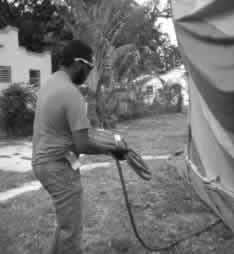2001

What We Learned about the Health Effects of Methyl-Bromide
and Sulfural fluoride (Vikane®)
We found small differences in performance on 2 tests of the nervous
system, among the men who worked with the fumigant, sulfuryl
fluoride (Vikane®), compared to non exposed
workers.
Among the tent crew workers, the small differences we found in 2
other tests may have been due to stresses caused by handling
heavy tarps and spring clamps.
The NIOSH study found no negative health effects on the kidneys
or the lungs. In 1992-1993, you helped us by taking part in
a NIOSH study about how methyl bromide and sulfuryl fluoride
(Vikane®) affects workers. These fumigants
are used to kill termites in buildings. This booklet tells you what we found
overall about the health effects of the fumigants we studied.
What Other Studies Suggested
Other studies have found that breathing in high amounts of methyl
bromide and sulfuryl fluoride (Vikane®)
harms the nervous system. Some studies suggested that working
with small amounts of methyl bromide for many years may reduce
memory. Those studies also found that persons who worked with
Vikane® for many years
did not score as well on some tests of the nervous system
as did workers who never worked with the sulfuryl fluoride.
Why We did the Study
We wanted to see if working with methyl bromide and Vikane®
for a long time harms the health of workers.
We wanted to see if working with these fumigants harms the nervous
system, the kidneys, or the lungs).
How We did the Study
In 1992 and 1993, we tested the nervous system of 2 groups of
workers. One group worked as shooters or tent crew workers.
We call the shooters and tent crew workers the “exposed
group”.
The other group was about the same age and was made up of friends
or neighbors of the exposed workers. These men said that they
had not worked with fumigants. The men in this group also
said that they had not worked with nor been poisoned by pesticides.
We call this group the “non-exposed group”.
Performance Tests
We did several different tests of the nervous system. Some of
the tests measured the following:
- ability to feel sensations in your arms, legs, hands, and feet
- hand-eye coordination
- ability to quickly react to various stimuli
- ability to identify different smells
- ability to control your balance without falling
- ability to use your fingers to move around small objects
- ability to remember patterns
The remaining tests looked at the “genotoxicity”
of methyl bromide, or its ability to damage DNA (the part
of the cell which carries the traits passed along to you from
your parents, and which also tells other parts of the cell
what to do). We looked at genetic mutation in lymphocytes
(HPRT and micronuclei) and in cells from the back of the mouth
(micronuclei). Everyone has some cells with HPRT damage, which
can result from everyday exposures.
Here is What We Found
For most tests, we found no differences in performance between
the exposed group and the non-exposed group. For the following
4 tests, the men who worked mainly with Vikane®
during the prior year had lower test scores than workers in
the non exposed group:
- remembering patterns
- using the main hand (the hand you prefer to use for most tasks)
to turn small pegs on a pegboard
- identifying differences in smells
- identifying the speed at which an electrical impulse traveled down a nerve in your lower arm
For the smaller number of men who worked mainly with methyl bromide,
there were no differences in their test scores compared to
the men who had not worked with pesticides.
Exposed workers also may have been more likely to have carpel tunnel
syndrome (CTS) than the non-exposed group. CTS is caused by
compression of a nerve in the wrist. It can cause pain and
numbness in the affected hand. We do not think the CTS was
caused by the fumigants. But we believe that the increase
in CTS may be related to handling clamps and heavy tarps.
The genetic tests suggested that workers exposed to methyl bromide
had slightly higher levels of genetic mutation. However, no
statistically significant differences were found in any tests
of the nervous system for the group exposed to methyl bromide
as compared to the non-exposed group.

Conclusions
For most tests of the nervous system, we found no differences
between the group exposed to Vikane® and the
non-exposed group. However, for the tests which showed differences,
we believe that the lower test scores among the exposed workers
are not likely to affect their day-to day ability to function.
The study suggested that workers exposed to methyl bromide had
slightly higher levels of genetic mutation. NIOSH considers
the genetic mutation tests to be experimental in that there
is no adequately demonstrated direct relationship between
the results and your health.
For more information or if you want copies of the study reports,
call 1-800-356-4674 between 9:00 a.m. and 4:00 p.m. Monday
through Friday, Eastern time.
NIOSH Publications
4676 Columbia Parkway
Cincinnati, OH
45226-1996
Fax: (513) 533-8573
Email: pubstaft@cdc.gov
Web site: www.cdc.gov/niosh